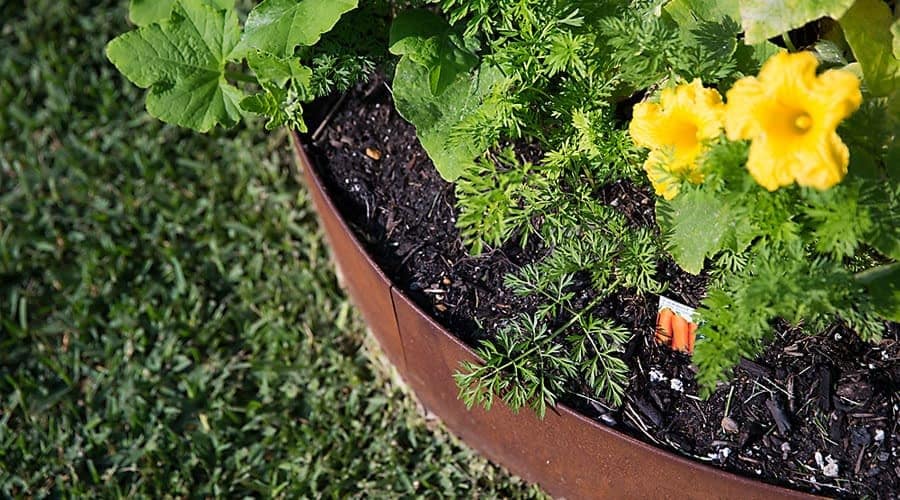Garden edging is a vital component of landscape design that helps define spaces, prevent grass and weeds from encroaching, and adds a clean, polished look to any outdoor area. Choosing the right garden edging material is crucial, as it impacts both the aesthetics and functionality of your garden. Among the various options available, metal garden edging stands out for its durability, sleek appearance, and versatility. In this comprehensive guide, we’ll compare metal edging with other common materials such as wood, plastic, stone, and brick, highlighting the pros and cons of each to help you make an informed decision for your garden.
1. Metal Edging: The Modern and Durable Choice
Metal garden edging is increasingly popular due to its modern look, strength, and ability to create precise, clean lines in any landscape. Available in materials such as galvanized steel, Corten steel, and aluminum, metal edging is known for its exceptional durability and low maintenance requirements.
Pros of Metal Edging:
- Exceptional Durability: Metal edging, particularly steel, is designed to withstand harsh weather conditions, including extreme heat, cold, and moisture. It does not warp, crack, or rot like other materials, ensuring long-lasting performance.
- Sleek Appearance: Metal edging provides a contemporary, minimalist look that enhances the aesthetics of modern and traditional gardens alike. Its clean lines create a professional finish that elevates any landscape design.
- Flexibility in Design: Flexible metal garden edging can be easily shaped to create curves, straight lines, or custom patterns, making it highly versatile for creative landscaping.
- Low Maintenance: Once installed, metal edging requires minimal upkeep. Galvanized steel and Corten steel are resistant to rust and corrosion, ensuring that your garden borders remain attractive over time.
- Eco-Friendly: Many metal edging products are made from recycled materials and can be recycled at the end of their lifespan, making them a sustainable choice.
Cons of Metal Edging:
- Higher Initial Cost: Metal edging tends to be more expensive upfront compared to materials like plastic or wood. However, its longevity often offsets the higher initial investment.
- Installation Complexity: While DIY-friendly, metal edging can be heavier and more challenging to install compared to lighter materials, especially for large projects.
2. Wood Edging: Natural and Rustic Appeal
Wood edging offers a warm, natural look that blends well with traditional, rustic, and cottage-style gardens. Commonly made from treated pine, cedar, or redwood, wood edging is a popular choice for those looking to add a softer, more organic touch to their landscape.
Pros of Wood Edging:
- Aesthetic Appeal: Wood edging provides a classic, rustic look that complements gardens with a natural or traditional design. It’s an ideal choice for those who prefer a more organic, earthy feel.
- Easy to Work With: Wood is relatively easy to cut, shape, and install, making it a DIY-friendly option for garden edging.
- Cost-Effective: Wood edging is generally less expensive than metal, stone, or brick, making it a budget-friendly choice for many homeowners.
Cons of Wood Edging:
- Prone to Rot and Decay: Despite being treated, wood edging is susceptible to rot, especially in wet or humid environments. It requires regular maintenance, including sealing or staining, to prolong its lifespan.
- Shorter Lifespan: Compared to metal, wood edging has a significantly shorter lifespan and may need to be replaced every few years due to weathering and decay.
- High Maintenance: To keep wood edging looking its best, regular maintenance is necessary, including treating the wood to protect it from moisture, insects, and UV damage.
3. Plastic Edging: Lightweight and Affordable
Plastic edging is a popular choice for quick and easy garden projects due to its lightweight nature, affordability, and ease of installation. It’s available in various styles and colors, allowing homeowners to match their garden’s aesthetic.
Pros of Plastic Edging:
- Affordable: Plastic edging is one of the most cost-effective options available, making it an attractive choice for budget-conscious gardeners.
- Lightweight and Easy to Install: Plastic edging is extremely lightweight and easy to cut, making it a convenient option for DIY projects that don’t require heavy tools or professional installation.
- Variety of Styles: Available in a wide range of styles, colors, and finishes, plastic edging can mimic the look of more expensive materials like stone or brick.
Cons of Plastic Edging:
- Lack of Durability: Plastic is prone to cracking, fading, and becoming brittle over time, especially when exposed to direct sunlight and extreme temperatures. This significantly reduces its lifespan compared to more durable materials like metal.
- Less Aesthetic Appeal: While plastic edging can be styled to mimic other materials, it often lacks the high-end appearance and sharp lines of metal or stone edging.
- Environmental Impact: Plastic edging is not eco-friendly, as it’s made from non-renewable materials and often ends up in landfills when replaced.
4. Stone and Brick Edging: Classic and Timeless
Stone and brick edging provide a timeless, elegant look that’s perfect for formal gardens, pathways, and driveways. These materials are known for their natural beauty and durability, making them a popular choice for creating permanent garden borders.
Pros of Stone and Brick Edging:
- Highly Durable: Stone and brick are among the most durable edging materials available, withstanding extreme weather conditions and providing a permanent solution for garden borders.
- Aesthetic Versatility: Stone and brick edging offer a classic, refined appearance that suits a wide range of garden styles, from traditional to contemporary.
- Low Maintenance: Once installed, stone and brick require little maintenance beyond occasional cleaning, making them a long-lasting option.
Cons of Stone and Brick Edging:
- High Cost and Labor-Intensive Installation: Stone and brick edging can be expensive, especially when considering the cost of materials and professional installation. The heavy nature of these materials also makes them difficult to work with for DIY projects.
- Limited Design Flexibility: Stone and brick edging are rigid and cannot be easily shaped or bent, limiting design options compared to more flexible materials like metal.
5. Rubber Edging: Eco-Friendly and Safe
Rubber edging, often made from recycled tires, is an eco-friendly option that provides a soft, flexible border ideal for gardens, playgrounds, and other areas where safety is a concern. It’s particularly popular in gardens where children and pets play, as it’s soft and resilient.
Pros of Rubber Edging:
- Eco-Friendly: Made from recycled materials, rubber edging is a sustainable choice that repurposes waste products.
- Flexible and Safe: Rubber edging is soft, flexible, and easy to install, making it a safe option for areas with high foot traffic or where children play.
- Resistant to Weather: Rubber does not rot, rust, or become brittle, ensuring a long-lasting garden border that can withstand harsh weather conditions.
Cons of Rubber Edging:
- Less Attractive Appearance: Rubber edging lacks the refined, polished look of materials like metal or stone, which may not suit more formal garden designs.
- Limited Design Options: Rubber edging is generally available in basic styles and colors, offering fewer aesthetic choices compared to other materials.
Why Metal Edging Is the Best Choice for Your Garden
While each garden edging material has its own set of benefits, metal garden edging emerges as the superior choice due to its combination of durability, aesthetics, and versatility. Here’s why metal edging outperforms other materials:
- Long-Lasting and Low Maintenance: Metal edging, particularly steel, offers unmatched longevity and requires little to no maintenance, making it a hassle-free solution that keeps your garden looking pristine.
- Sleek and Modern Aesthetics: The clean lines and minimalist look of metal edging add a contemporary touch to any garden, enhancing the overall design without overwhelming it.
- Design Flexibility: Metal edging can be shaped to fit any garden layout, allowing you to create custom designs that reflect your personal style and vision.
- Sustainable and Environmentally Friendly: Many metal edging products are made from recycled materials and can be recycled at the end of their life, supporting eco-friendly gardening practices.
Conclusion
Choosing the right garden edging material is essential for creating a beautiful, functional, and long-lasting landscape. While wood, plastic, stone, and rubber each offer unique benefits, metal garden edging stands out as the best option for those seeking a durable, stylish, and versatile solution. Whether you’re defining borders, outlining pathways, or adding a modern touch to your garden, metal edging provides the high-quality finish and performance needed to elevate your outdoor space.
Explore the range of metal garden edging options available at Greenlines to find the perfect fit for your garden. With various styles, finishes, and sizes, Greenlines offers the ideal edging solutions to enhance your landscape and keep it looking its best for years to come.


